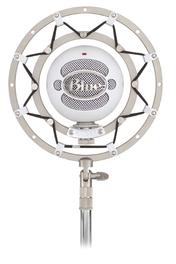Blue Snowball USB Microphone
![]()
![]()
![]()
![]()
![]()
![]()
![]()
![]()

Just this side of too cool to be real, the Blue Snowball is neither blue nor made of snow. It is, however, one of the slickest devices in the known universe to plug into a USB port.
In ages past, getting sound into a PC was a bit of a labor. The options for doing so included plugging a conventional microphone into the audio input of your sound card – which worked flawlessly, but typically sounded like a long-distance call to Mars – or springing for an expensive and mind-numbingly complex external analog to digital converter, and then hiring a team of research alchemists to consult on how to install the beast.
The Blue Snowball bypasses all this antediluvian technology. It’s a superb microphone – actually, two of them – and a built in digital converter. Plug it into a USB port and it will pop up as a new sound source, all ready to record from.
People who fail abysmally at operating their own noses can make one of these things work. There are no drivers to install or control panel applets to adjust. It doesn’t even have a volume control.
Once it’s up and running, you can select the Blue Snowball as a conventional Windows or Macintosh sound source.
The Blue Snowball features one omni-directional capsule and one cardioid capsule – there’s a switch at the back of the microphone to select the one you’d like to use. The former will pick up pretty much anything near the microphone. The latter will only hear what’s directly in front of it, effectively canceling most extraneous room noise.
The Blue Snowball samples at 44.1 kilohertz, with sixteen-bit resolution, this being comparable to the audio quality of a compact disc. It has a frequency response of 40 hertz to 18 kilohertz, which is a great deal wider than the frequency response of my ears, even on a really good day.
The Snowball can be used to record with any software that accepts sound. Played into the Windows Sound Recorder, it produces pristine, studio-quality recordings the like of which Windows Sound Recorder has clearly never hitherto experienced. Permitted to drive real studio software – we used Sony Acid – it totally rocks. It can do justice to a single acoustic guitar, or to an entire band turned up to ten.
It also makes a superbly capable vocal microphone. It’s remarkably forgiving of sibilance and other vocal noises. If you’re into podcasting, its sound quality and ease of use defy improvement.
The Snowball comes with an integrated tripod stand, which puts it at a comfortable height above the desktop it resides upon to speak into.

In addition to the Snowball itself, as illustrated at the beginning of this review, Blue Microphones offers a shock mount for the Snowball which the call the Ringer. The Ringer isolates the Snowball from vibrations that would otherwise be transmitted through its stand and picked up by its microphone capsule. While it works well and it looks agreeably retro, it’s worth noting that the Ringer is considerably larger than the Snowball itself, to some extent defeating the compact nature of this device.
Despite its impeccable technology, the Blue Snowball is startlingly inexpensive. As of this writing, it will beat up your credit card for about eighty dollars, with its optional Ringer shock mount looking for another sixty.
By comparison, a good conventional analog condenser microphone and a workable digital converter would cost two or three times this, and then you’d be into deductibles and co-payments for the subsequent therapy and tranquilizers to help you recover from the trauma brought about by reading the documentation for all that stuff.
Finally, the Blue Snowball looks like a bit of history – its retro appearance and general air of funkiness almost make it worth owning even if the only thing you know how to play is an iPod. It could have beamed in from another planet, or a time warp from the golden age of radio.
Your desk needs one of these.